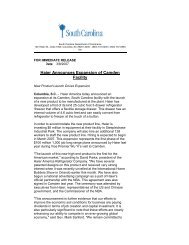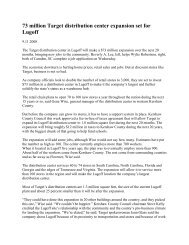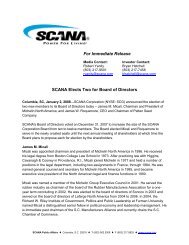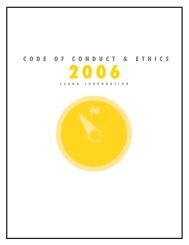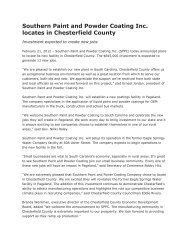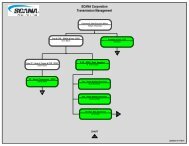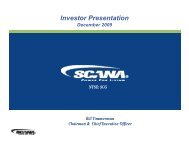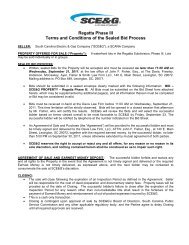SCEG OATT Formula Transmission Rate Filing.pdf - SCANA ...
SCEG OATT Formula Transmission Rate Filing.pdf - SCANA ...
SCEG OATT Formula Transmission Rate Filing.pdf - SCANA ...
Create successful ePaper yourself
Turn your PDF publications into a flip-book with our unique Google optimized e-Paper software.
20091231-0037 FERC PDF (Unofficia1) 12/29/2009<br />
Exhibit No. SCE-2<br />
How Returns On Equity Factor Into U.S. Utilities' Creditworthiness<br />
costs in base rates could impair a utility's ability to earn the authorized ROE. Commissions may set rates based<br />
on historical levels that are lower than actual amounts, reducing the ability to earn the authorized ROE because<br />
additional fuel and purchased-power<br />
income.<br />
costs could be incurred without rate recovery, ultimately lowering net<br />
• Depreciation expense. Higher depreciation expense provides timely rate recovery of inve~tments and stronger cash<br />
flow, but lower earnings and earned ROEs. If depredation<br />
match the useful lives of plant and equipment, and cash flow will be lower.<br />
levels are low, rate recovery of investments may not<br />
• Taxes other than income taxes. Property taxes and other taxes could rise above the level in rates, and result in<br />
earnings and cash flow erosion.<br />
• Return on rate base. The weighted average cost of capital (WACC), or overall return, multiplied by a utility's rate<br />
base results in an authorized return on rate base from which interest expense and dividends are paid. Multiple<br />
variables in this calculation can affect a utility's ability to earn its authorized ROE. The return can be lowered by<br />
relying on a WACC<br />
(overall return) that is calculated with interest rates lower than actual rates, a lower ROE, or<br />
a capital structure that may have a lower common equity component,<br />
all of which can affect a utility's ability to<br />
earn the authorized ROE. If a publicly traded utility issues additional equity after a rate case, the ability to earn<br />
its authorized ROE will be hindered.<br />
• <strong>Rate</strong> base. Another component of the return calculation is the rate-base level. If a commission relies on an<br />
outdated rate base or excludes plant from rate base if not "used and useful" when.setting rates, a utility could<br />
almost immediately experience earnings and cash flow erosion. In addition, if recovery of carrying costs on<br />
capital spending is disallowed unti] after the plant is considered useful, incremental earnings erosion will occur.<br />
Alternatively, cash flow and earnings would be strengthened if a commission allows the rate base to be updated.<br />
• Income taxes. If actual income taxes are higher than the level used to set rates, earnings and the ROE will be<br />
lower.<br />
• Test period. Partly or fully forecast test periods reduce regulatory lag by providing for recovery of estimated<br />
expenses that may be incurred in the near term. Using a historical test period without updates makes it more<br />
difficult to earn the authorized ROE because expenses may have already increased during the rate case (which can<br />
take many months to complete), resulting in cost recovery that is too low even after new rates are set. Credit<br />
quality benefits from forecast test periods and less so from updated historical test periods.<br />
• Other disallowances. A commission could disallow recovery of an acquisirion premium, resulting in lower<br />
earnings and cash flow.<br />
• <strong>Rate</strong> design. A utility's actual rate structure can affect a utility!s ability to earn its authorized ROE. Cash flows<br />
are more stable and earnings more predictable when a higher percentage of a utilitis<br />
costs are recoverable<br />
through the fixed charge paid by customers regardless of electricity used and the first-rate block of typical<br />
monthly energy usage.<br />
• Timeliness. The faster a commission approves new rates, the quicker the improvement in cash flow and the better<br />
a utility'S opportunity<br />
to earn its authorized ROE due to reduced regulatory lag. If a final ruling cannot be issued<br />
in a timely manner, a commission's ability to issue an interim rate ruling provides rate relief and lowers financial<br />
uncertainty about ultimate rate recovery.<br />
Regulatory Mechanisms<br />
Certain regulatory mechanisms may be available to commissions that, if used, can strengthen a company's cash<br />
flow. Earnings and cash flow should improve if such mechanisms are used. Among the items that could require<br />
www.standardandpoors.com/ratingsdirecl . 3<br />
Standard & POOl's.All rights reserved. No reprint Of dissemination without sSP'spermissi()ll. See Terms of lhIejOisclaimer Oflltle lasl page.



